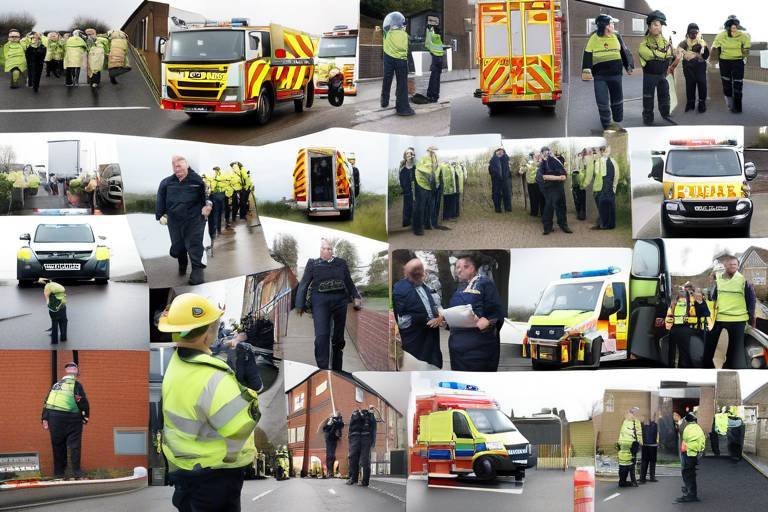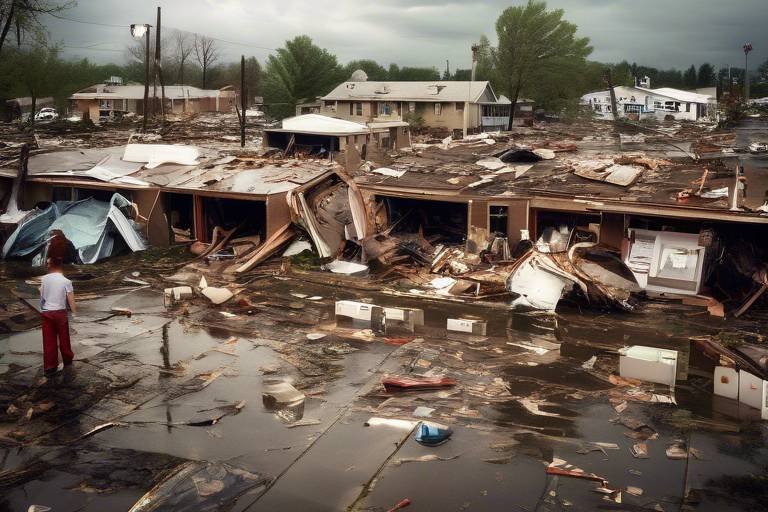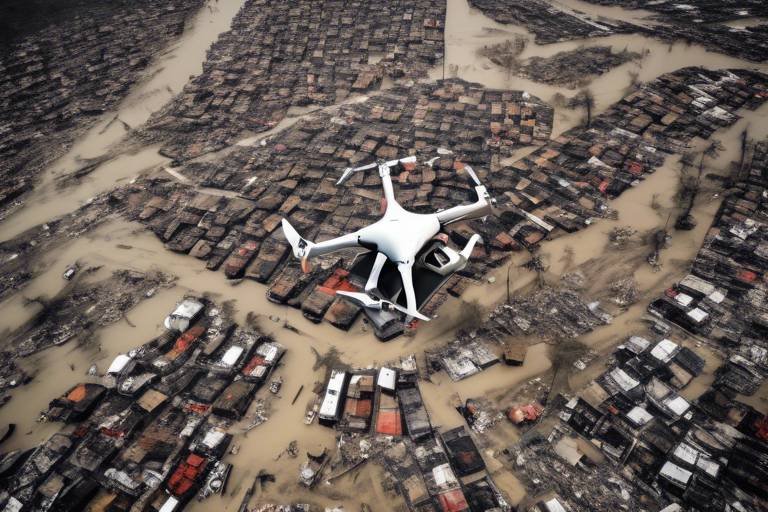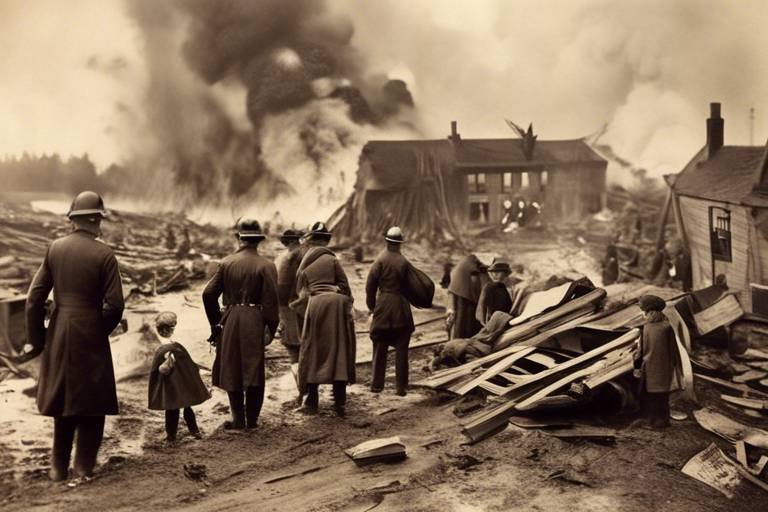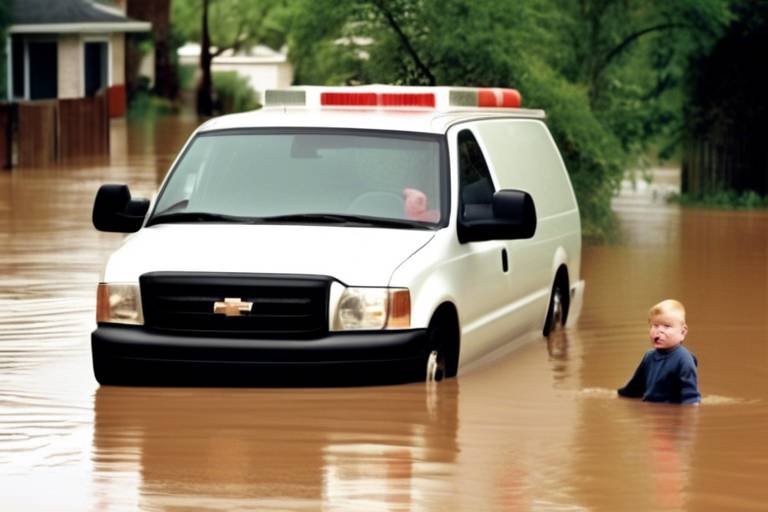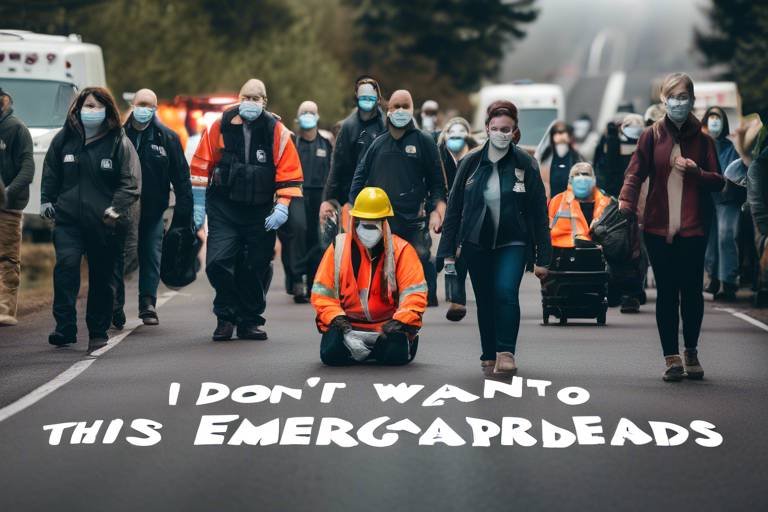Roles and Responsibilities of Local Authorities in Emergency Response
In times of crisis, the role of local authorities becomes paramount. They are the first line of defense when emergencies strike, whether it's a natural disaster, public health crisis, or any other calamity. Local authorities, including city councils and municipal governments, wield significant influence and responsibility in managing these situations. Their actions can mean the difference between chaos and order, life and death, safety and danger. This article delves into the critical functions that local authorities play during emergencies, detailing their responsibilities, coordination efforts, and the impact of their actions on community safety and resilience.
Emergency management is a comprehensive approach that encompasses various phases: preparedness, response, recovery, and mitigation. Local authorities must navigate these phases effectively to ensure their communities are safe and resilient. Preparedness involves planning and training to handle potential emergencies. The response phase is where immediate actions are taken to protect lives and property. Following an incident, recovery focuses on restoring normalcy, while mitigation aims to reduce the impact of future emergencies. Each phase requires a coordinated effort from local authorities to be successful.
Local authorities have a plethora of specific duties in emergency response. They are responsible for planning effective strategies, allocating resources, and coordinating with various agencies to ensure that disasters are managed efficiently. Their responsibilities can be categorized into several key areas:
- Emergency Preparedness Planning: This is about assessing risks and developing response strategies. Local authorities must ensure that communities are well-equipped for potential emergencies.
- Coordination with Emergency Services: Collaboration with police, fire departments, and medical services is essential for a unified response.
- Resource Management: This involves managing personnel, equipment, and funding to ensure all necessary assets are available.
Effective emergency preparedness planning is not just a checkbox on a to-do list; it’s a vital process that involves assessing risks, developing response strategies, and ensuring that communities are equipped for potential emergencies. Local authorities must conduct thorough risk assessments to identify vulnerabilities within their communities. This proactive approach allows them to craft tailored response strategies that can be swiftly implemented when the need arises. Think of it like preparing for a big storm: you wouldn't wait until the clouds are rolling in to gather supplies, would you?
To bolster their preparedness efforts, local authorities conduct training sessions and drills. These activities enhance the readiness of first responders and community members alike. Imagine a fire drill at school—everyone knows what to do when the alarm goes off. Similarly, regular training ensures that when real emergencies occur, everyone knows their roles and responsibilities, leading to a more effective response.
Engaging with the community is another critical aspect of local authorities' responsibilities. By gathering input and educating the public, they foster a culture of preparedness. This engagement not only informs residents about potential risks but also empowers them to take proactive measures. When communities are informed and involved, they become more resilient during emergencies, much like a tightly-knit family that supports one another in tough times.
Collaboration with emergency services is essential for local authorities to ensure a unified and effective response during crises. This coordination includes regular communication and joint training exercises to enhance teamwork. By working closely with police, fire departments, and medical services, local authorities can ensure that every aspect of the emergency response is covered, creating a seamless operation that maximizes efficiency and effectiveness.
Resource management is another critical function of local authorities during emergencies. They are responsible for managing personnel, equipment, and funding to ensure that all necessary assets are available and efficiently utilized. This involves not just having the right resources on hand but also knowing how to deploy them effectively when the situation demands.
Securing adequate funding and budgeting for emergency response initiatives is crucial. Local authorities must prioritize emergency preparedness in their budgets to maintain readiness. Think of it as investing in insurance—you hope you never need it, but when disaster strikes, you'll be glad you have it. Without proper funding, the effectiveness of emergency response can be severely compromised, leaving communities vulnerable.
Providing logistical support is a key responsibility of local authorities. This includes transportation and supply chain management to facilitate the timely delivery of aid and resources during emergencies. Imagine trying to deliver food and water to a community cut off by a flood without a solid logistical plan—it would be a chaotic situation. Local authorities must ensure that logistics are streamlined, so help reaches those in need as quickly as possible.
After an emergency, local authorities play a critical role in recovery efforts. They focus on rebuilding infrastructure, providing support services, and helping communities return to normalcy while addressing long-term needs. Recovery is not just about fixing what was broken; it’s about rebuilding stronger and smarter. Local authorities work to ensure that lessons learned during the crisis are applied to future planning, making communities more resilient than before.
- What are the main roles of local authorities in emergency response?
Local authorities are responsible for planning, resource management, coordination with emergency services, and community engagement during emergencies.
- How do local authorities prepare for emergencies?
They conduct risk assessments, develop response strategies, and hold training sessions and drills to ensure readiness.
- Why is community engagement important in emergency management?
Engaging the community helps gather input, educate the public, and foster a culture of preparedness, which enhances resilience.

Understanding Emergency Management
Emergency management is a comprehensive discipline that involves a series of coordinated efforts to prepare for, respond to, recover from, and mitigate the impacts of disasters. Think of it as a well-oiled machine, where each part plays a vital role in ensuring the safety and resilience of a community. Local authorities are at the heart of this machine, acting as the primary coordinators during emergencies. Their responsibilities span across four key phases: preparedness, response, recovery, and mitigation. Each phase is crucial, and together they create a cycle that ensures communities are not just surviving but thriving even in the face of adversity.
During the preparedness phase, local authorities assess potential risks that their communities might face. This involves identifying hazards—be it natural disasters like floods and earthquakes or man-made incidents such as chemical spills. Once risks are identified, authorities develop response strategies, which can include creating emergency response plans, establishing communication protocols, and conducting training sessions for first responders and community members alike. This proactive approach is essential; it’s like setting up a safety net before the tightrope walk begins.
When an emergency strikes, the response phase kicks in. Local authorities coordinate with various agencies and organizations to ensure that help is delivered swiftly and effectively. This is where the magic of teamwork comes into play. Imagine a conductor leading an orchestra; each musician (or agency) must know their role and be ready to play in harmony. Local authorities are responsible for orchestrating this response, ensuring that police, fire services, medical teams, and volunteers work together seamlessly.
After the immediate threat has passed, the recovery phase begins. This phase is all about rebuilding and restoring normalcy. Local authorities take charge of assessing the damage, providing support services, and helping the community bounce back. It’s not just about fixing what was broken; it’s also about addressing the long-term needs of the population. They might implement programs to assist families who lost their homes or provide mental health resources for those affected by trauma. Recovery is a journey, and local authorities are the guides, helping their communities navigate the path back to stability.
Finally, there’s the mitigation phase, which focuses on reducing the impact of future disasters. This might involve updating building codes, investing in better infrastructure, or creating awareness campaigns to educate the public about disaster preparedness. Think of mitigation as planting seeds for a more resilient future; the more effort put into this phase, the better equipped a community will be to handle whatever challenges lie ahead.
In summary, understanding emergency management is crucial for local authorities. They play an indispensable role throughout all phases of emergency management, ensuring that communities are not only prepared for emergencies but also capable of recovering and thriving afterwards. By fostering a culture of preparedness and resilience, local authorities can significantly reduce the impacts of disasters, ultimately protecting lives and property.

Key Responsibilities of Local Authorities
Local authorities hold a pivotal role in emergency response, acting as the frontline defenders of community safety. Their responsibilities are multifaceted and require a blend of strategic planning, resource management, and community engagement. When disaster strikes, whether it’s a natural calamity like a flood or an unforeseen event such as a pandemic, local authorities are the ones who spring into action, coordinating efforts to mitigate damage and ensure public safety.
One of the primary responsibilities of local authorities is emergency preparedness planning. This involves not only creating comprehensive plans that outline the steps to be taken during various types of emergencies but also assessing potential risks that could impact the community. They must consider factors such as geographical vulnerabilities, population density, and available resources. By identifying these risks, local authorities can develop tailored response strategies that enhance community resilience.
In addition to planning, local authorities are tasked with resource allocation. This means ensuring that the right personnel, equipment, and supplies are available when needed. For instance, during a wildfire, local authorities must coordinate with fire departments to deploy firefighters, secure firefighting equipment, and manage logistics for evacuations. Effective resource management can be the difference between a swift response and a chaotic situation that exacerbates the disaster's impact.
Moreover, coordination with various agencies is essential. Local authorities work closely with emergency services, non-profit organizations, and even private sector partners to ensure a unified response. This collaboration not only streamlines communication but also maximizes the use of resources. For example, during a major storm, local authorities might coordinate with utility companies to expedite power restoration efforts, ensuring that communities can return to normalcy as quickly as possible.
Another critical aspect of their role is community engagement. Local authorities must actively involve community members in the planning and response processes. This can include public meetings, surveys, and educational campaigns aimed at informing citizens about emergency preparedness. When communities are educated and involved, they are more likely to respond effectively in a crisis, thus enhancing overall resilience. Engaging with the community also helps local authorities gather valuable feedback, which can be used to improve future emergency plans.
Finally, local authorities must ensure that they are continuously updating their emergency response protocols based on lessons learned from previous incidents. This iterative process of improvement is crucial for adapting to new challenges, such as climate change or evolving public health threats. By regularly reviewing and revising their strategies, local authorities can stay ahead of potential emergencies and ensure that they are prepared to protect their communities.
- What is the role of local authorities in emergency management?
Local authorities are responsible for planning, coordinating, and executing emergency responses, ensuring community safety and resilience. - How do local authorities prepare for emergencies?
They prepare through risk assessment, developing response strategies, and conducting training and drills with first responders and community members. - Why is community engagement important in emergency response?
Engaging the community fosters a culture of preparedness, ensures public input, and enhances the effectiveness of emergency plans. - How do local authorities manage resources during a crisis?
They allocate personnel, equipment, and funding effectively, ensuring that all necessary assets are available for a swift response.

Emergency Preparedness Planning
Effective is not just a checkbox on a to-do list; it’s a vital component of community safety that local authorities must prioritize. Imagine a well-oiled machine that kicks into action the moment a crisis strikes. This is what local authorities aim to create through meticulous planning and foresight. The process begins with a thorough assessment of potential risks that could impact the community, such as natural disasters, pandemics, or industrial accidents. By identifying these risks, local authorities can develop tailored response strategies that address the unique challenges their communities may face.
Moreover, engaging with community members during this planning phase is crucial. It's not just about top-down directives; local authorities must actively listen to residents’ concerns and suggestions. This engagement fosters a sense of ownership and empowerment among community members, making them more likely to participate in preparedness efforts. For instance, local authorities might organize town hall meetings or surveys to gather input on emergency plans. The information gathered can be invaluable in shaping a comprehensive preparedness strategy that meets the needs of all community members.
Another essential aspect of emergency preparedness planning is ensuring that communities are equipped with the necessary resources and knowledge to respond effectively. This includes not only physical resources, such as emergency kits and communication tools, but also educational programs that teach residents about emergency procedures. For example, local authorities might implement workshops on first aid, evacuation routes, and the importance of emergency contacts. By empowering residents with knowledge, local authorities help create a resilient community that can withstand and recover from emergencies.
To visualize the importance of these elements, consider the following table that outlines key components of emergency preparedness planning:
| Component | Description |
|---|---|
| Risk Assessment | Identifying potential hazards that could impact the community. |
| Community Engagement | Involving residents in the planning process to gather valuable input. |
| Resource Allocation | Ensuring the availability of necessary resources for effective response. |
| Education and Training | Providing workshops and training sessions to equip residents with knowledge. |
Ultimately, the goal of emergency preparedness planning is to create a seamless response mechanism that can be activated when needed. By investing time and resources into this planning phase, local authorities not only enhance the safety and resilience of their communities but also foster a culture of preparedness that can save lives. So, the next time you hear about a community's emergency plan, remember that it’s the result of careful thought, collaboration, and a commitment to protecting the people who call that community home.
- What is the primary goal of emergency preparedness planning? The main goal is to ensure that communities are ready to respond effectively to emergencies, minimizing risks and enhancing safety.
- How can community members get involved in emergency preparedness? Residents can participate by attending planning meetings, providing feedback, and participating in training sessions organized by local authorities.
- What resources are typically included in an emergency preparedness plan? Resources may include emergency kits, communication tools, evacuation routes, and educational materials for residents.

Training and Drills
When it comes to emergency preparedness, are not just optional—they are absolutely essential. Local authorities understand that being ready for a crisis is like preparing for a marathon; it requires consistent practice, stamina, and strategy. Just as athletes don’t show up on race day without having logged countless hours of training, communities cannot expect to respond effectively to emergencies without rigorous preparation. These training sessions and drills serve multiple purposes, from enhancing the skills of first responders to educating the public about what to do when disaster strikes.
One of the primary objectives of these drills is to simulate real-life scenarios that could occur during an emergency. For instance, local authorities might conduct fire drills, earthquake preparedness exercises, or even flood response simulations. These exercises allow both emergency personnel and community members to practice their roles in a controlled environment, reducing panic and confusion when a real crisis happens. Imagine being in a crowded theater when the fire alarm goes off. If you’ve practiced the emergency exit routes before, you’re more likely to stay calm and help others evacuate safely.
Moreover, local authorities often collaborate with various stakeholders—like schools, hospitals, and community organizations—to facilitate these training sessions. This collaboration is akin to a well-rehearsed orchestra where each musician knows their part and plays in harmony with the others. Effective communication during these drills is vital. It ensures that everyone involved understands their roles and responsibilities, creating a seamless response when the real deal occurs.
To give you a clearer picture, here’s a breakdown of typical training components:
| Training Component | Description |
|---|---|
| Tabletop Exercises | Discussions that simulate emergency scenarios to test decision-making processes. |
| Field Drills | Hands-on practice in realistic environments to apply learned skills. |
| Community Workshops | Sessions aimed at educating the public on preparedness and response strategies. |
| Evaluation and Feedback | Post-drill assessments to identify strengths and areas for improvement. |
In addition to structured training, local authorities also focus on community engagement to ensure that everyone knows what to do in an emergency. This could involve hosting community meetings where residents can ask questions and express concerns, or distributing informative materials that outline emergency procedures. The more informed the public is, the less likely they are to panic during a crisis. Think of it as preparing for a big exam; the more you study, the more confident you feel when the test day arrives.
Ultimately, the goal of training and drills is to build a culture of preparedness within the community. When residents feel empowered and knowledgeable about emergency response, they contribute to a stronger, more resilient community. This proactive approach not only saves lives but also fosters a sense of unity among community members. After all, in times of crisis, we’re all in this together.
- Why are training and drills important for local authorities? They prepare both emergency responders and the public for real-life emergencies, ensuring a coordinated and effective response.
- How often should training and drills be conducted? Regular training should occur at least annually, with additional drills scheduled as needed based on community risks.
- Can community members participate in these drills? Absolutely! Community engagement is crucial for effective emergency preparedness.
- What types of scenarios are typically practiced in drills? Common scenarios include fires, floods, earthquakes, and medical emergencies.

Community Engagement
is not just a buzzword; it's the lifeblood of effective emergency management. Local authorities must actively involve their communities in the planning and response processes to cultivate a culture of preparedness. Imagine a town where every resident feels empowered and informed about what to do in an emergency. That’s the kind of community we want to build! By fostering strong relationships with community members, local authorities can gather invaluable input and insights that enhance their emergency response strategies.
One of the primary ways local authorities engage with the community is through public education campaigns. These campaigns can take many forms, from workshops and informational pamphlets to social media outreach and community meetings. The goal is to ensure that everyone knows the risks they face and the steps they can take to mitigate those risks. For instance, a simple flyer outlining the steps to take during a flood can save lives and reduce panic when disaster strikes.
Moreover, local authorities can organize community drills that simulate emergency scenarios. These drills not only prepare residents for real-life emergencies but also strengthen the bond between community members. When neighbors come together to practice evacuation routes or fire safety protocols, they build trust and camaraderie, making it easier to rely on one another when the chips are down. Think of it like a neighborhood potluck, but instead of sharing recipes, you’re sharing safety tips!
Another effective strategy is to establish community advisory boards. These boards can consist of local residents, business owners, and other stakeholders who provide feedback on emergency plans and initiatives. By including diverse voices in the conversation, local authorities can ensure that their strategies are comprehensive and reflect the unique needs of their communities. This collaborative approach not only enhances the effectiveness of emergency plans but also fosters a sense of ownership among residents.
It's essential to remember that community engagement is a two-way street. Local authorities should not only disseminate information but also actively listen to the community’s concerns and suggestions. This dialogue can be facilitated through surveys and feedback sessions, allowing residents to express their views on emergency preparedness and response initiatives. The more local authorities listen, the better they can tailor their strategies to meet the community's needs.
In summary, community engagement is a cornerstone of effective emergency management. It empowers residents, fosters collaboration, and ultimately enhances community resilience. When local authorities prioritize engagement, they not only prepare their communities for emergencies but also build a stronger, more connected society. So, let's roll up our sleeves and work together—because when it comes to safety, we’re all in this together!
- Why is community engagement important in emergency management?
Community engagement ensures that residents are informed, prepared, and can effectively respond during emergencies, leading to better outcomes for everyone. - How can local authorities effectively engage with their communities?
Through public education campaigns, community drills, advisory boards, and open dialogues, local authorities can foster meaningful engagement. - What role do community members play in emergency preparedness?
Community members provide valuable input, participate in training and drills, and help disseminate information to others, enhancing overall community resilience.

Coordination with Emergency Services
When a crisis strikes, the clock is ticking, and every second counts. This is where the becomes paramount. Local authorities serve as the backbone of emergency response, ensuring that various agencies—such as police, fire departments, and medical services—work in unison to tackle the situation at hand. Imagine a well-rehearsed orchestra; each musician has a role, and when they play together, the result is harmonious and effective. In the same way, local authorities must synchronize their efforts with emergency services to ensure a seamless response to emergencies.
Effective coordination begins long before an emergency occurs. Local authorities engage in strategic planning sessions with emergency services, establishing clear lines of communication and protocols. This proactive approach not only helps in identifying potential gaps in response capabilities but also fosters trust among the agencies involved. For example, regular meetings and joint training exercises can significantly enhance inter-agency relationships, making it easier to collaborate during high-pressure situations.
Moreover, during an emergency, local authorities must act as the central command, directing resources and personnel where they are needed most. This involves real-time communication with emergency services to assess the situation and respond accordingly. For instance, if a natural disaster occurs, local authorities must quickly relay information about affected areas to fire departments for rescue operations and to medical services for triaging victims. The flow of information is crucial, and any breakdown can lead to disastrous consequences.
In addition to communication, local authorities also play a vital role in resource allocation. They must ensure that emergency services have the necessary equipment and personnel to respond effectively. This can include everything from providing additional ambulances during a mass casualty incident to coordinating with local hospitals to prepare for an influx of patients. The ability to manage these resources efficiently can be the difference between chaos and order in the aftermath of an emergency.
Furthermore, local authorities need to engage the community in their emergency planning efforts. By educating residents about how to respond in emergencies and involving them in drills, local authorities can enhance community resilience. When citizens are aware of their roles and responsibilities, they can assist emergency services in crucial ways, such as reporting incidents or helping neighbors in need. This community involvement not only strengthens the overall response but also fosters a sense of unity and preparedness.
In conclusion, the coordination between local authorities and emergency services is a critical aspect of effective emergency management. By fostering strong relationships, establishing clear communication channels, and engaging the community, local authorities can ensure that their response to emergencies is not only swift but also efficient. After all, in the face of adversity, it's the collective efforts that pave the way for recovery and resilience.
- What role do local authorities play in emergency response?
Local authorities are responsible for coordinating the efforts of various emergency services, ensuring effective communication, and managing resources during crises. - How do local authorities prepare for emergencies?
They engage in strategic planning, conduct training exercises, and build relationships with emergency services to enhance readiness. - Why is community involvement important in emergency planning?
Community involvement helps educate residents about emergency procedures and fosters a culture of preparedness, making the overall response more effective.

Resource Management in Emergencies
Resource management during emergencies is a critical function that local authorities must master to ensure a swift and effective response. When a disaster strikes, the clock is ticking, and every second counts. Local authorities are tasked with the immense responsibility of managing various resources, including personnel, equipment, and funding. This management is not merely about having resources on hand; it’s about ensuring that these resources are available, accessible, and effectively utilized to meet the needs of the community in crisis.
One of the first steps in resource management is conducting a thorough assessment of needs. Local authorities must evaluate the situation on the ground, understanding what resources are required, where they are needed most, and how quickly they can be deployed. This often involves collaboration with emergency services, non-profit organizations, and community groups to gather accurate data. For instance, during a natural disaster like a hurricane or flood, local authorities might need to assess the number of shelters required, medical supplies, and personnel needed for rescue operations.
To illustrate the complexity of resource management, consider the following table that outlines the types of resources typically managed during an emergency:
| Resource Type | Description | Example |
|---|---|---|
| Personnel | Emergency responders, volunteers, and support staff | Firefighters, paramedics, and community volunteers |
| Equipment | Tools and machinery needed for rescue and recovery | Fire trucks, ambulances, and heavy machinery |
| Funding | Financial resources allocated for emergency operations | Grants, emergency funds, and community donations |
Another crucial aspect of resource management is logistical support. Local authorities must ensure that the necessary supplies are delivered to the right locations at the right time. This includes coordinating transportation, managing supply chains, and establishing distribution points for food, water, and medical supplies. The logistics of emergency response can often be as challenging as the emergency itself, requiring meticulous planning and real-time decision-making.
Moreover, local authorities must also focus on training and preparedness. This means not only preparing their own staff but also ensuring that community members are aware of how to access resources during an emergency. For example, public awareness campaigns can inform residents about local shelters, emergency hotlines, and available medical assistance. By fostering a culture of preparedness, local authorities can enhance community resilience, ensuring that individuals know where to turn for help when disaster strikes.
Lastly, securing adequate funding is essential. Local authorities often face the challenge of budgeting for emergencies in advance. This means setting aside funds for unforeseen circumstances and ensuring that there is a financial plan in place for quick mobilization of resources when needed. Without proper funding, even the best-laid plans can fall apart, leaving communities vulnerable during crises.
In summary, effective resource management in emergencies is a multifaceted responsibility that local authorities must navigate with precision. By assessing needs, managing logistics, training personnel, and securing funding, they can significantly enhance their community's ability to respond to and recover from disasters.
- What are the primary resources managed by local authorities during emergencies? Local authorities manage personnel, equipment, and funding to respond effectively to emergencies.
- How do local authorities assess the needs of a community during a disaster? They conduct thorough evaluations, often collaborating with emergency services and community groups to gather accurate data.
- Why is logistical support important in emergency management? Logistical support ensures that necessary supplies are delivered promptly to the right locations, enhancing the effectiveness of the response.
- What role does community engagement play in resource management? Engaging the community helps local authorities educate residents about available resources and fosters a culture of preparedness.

Funding and Budgeting
When it comes to emergency response, are not just numbers on a spreadsheet; they are the lifeblood that ensures local authorities can respond effectively to crises. Imagine a fire department without the necessary equipment or a medical service without adequate supplies. It’s like trying to fight a fire with a garden hose—ineffective and dangerous. Local authorities must carefully plan their budgets to allocate resources effectively, ensuring that every dollar spent translates into enhanced community safety.
One of the first steps in effective is identifying the specific needs of the community. This involves conducting thorough assessments to understand potential risks and the resources required to address them. For instance, a community prone to floods may need to invest more in water rescue equipment and training, while an area with a high incidence of wildfires might prioritize fire prevention measures. By tailoring their budgets to the unique challenges they face, local authorities can maximize their impact during emergencies.
Furthermore, securing adequate funding is crucial. Local authorities often rely on a mix of federal grants, state funding, and local taxes to build their emergency response budgets. Understanding how to navigate these funding sources can be a game changer. For example, many federal programs offer grants specifically designed for enhancing emergency preparedness and response capabilities. Local authorities must stay informed about these opportunities and actively apply for them to bolster their financial resources.
In addition to securing funding, local authorities must also prioritize budgeting for training and equipment. This includes not only the purchase of necessary gear but also investing in regular training sessions for emergency personnel. A well-trained team is essential for an effective response. Imagine a fire crew that hasn’t practiced in months; their efficiency and effectiveness would be compromised when it matters most. Therefore, budgeting for ongoing training is not just a recommendation; it's a necessity.
Another important aspect of funding and budgeting is logistical support. This includes ensuring that there are adequate supplies, such as food, water, and medical kits, readily available during emergencies. Local authorities should establish contracts with suppliers to guarantee that essential resources can be delivered swiftly when crises arise. Think of it as having a well-stocked pantry before a big storm hits—preparation can make all the difference.
To illustrate the importance of effective funding and budgeting in emergency management, consider the following table that outlines key areas of expenditure and their potential impact on emergency response capabilities:
| Expenditure Area | Impact on Emergency Response |
|---|---|
| Training Programs | Enhances readiness and response time |
| Equipment Purchase | Ensures availability of necessary tools |
| Community Outreach | Increases public awareness and preparedness |
| Logistical Support | Facilitates timely aid delivery |
In conclusion, funding and budgeting are not merely administrative tasks; they are pivotal in shaping the effectiveness of local authorities during emergencies. By prioritizing these aspects, local authorities can ensure that they are not only prepared to respond but also capable of leading their communities toward recovery and resilience. After all, in the face of an emergency, every second counts, and every dollar spent wisely can save lives and restore hope.
- What are the main sources of funding for local authorities during emergencies?
Local authorities typically rely on a combination of federal grants, state funding, and local taxes to finance their emergency response initiatives.
- How can local authorities ensure they are adequately prepared for emergencies?
By conducting thorough risk assessments, securing funding, and investing in training and equipment, local authorities can enhance their preparedness for various emergencies.
- Why is community engagement important in emergency funding and budgeting?
Engaging the community helps local authorities understand specific needs and gather input, which can lead to more effective budgeting and resource allocation.

Logistical Support
When a disaster strikes, the clock is ticking, and every second counts. This is where becomes the backbone of emergency response efforts by local authorities. Imagine a well-oiled machine, each cog working in harmony to deliver aid, resources, and support to those in need. Local authorities must ensure that the right resources are in the right place at the right time, which requires meticulous planning and execution.
Logistical support encompasses a variety of tasks, including transportation, supply chain management, and coordination of resources. For instance, during a natural disaster like a flood or hurricane, local authorities need to swiftly organize the movement of personnel and equipment to affected areas. This involves not just vehicles, but also ensuring that fuel supplies are available and routes are clear. It's akin to a chess game, where every move must be calculated to avoid pitfalls and ensure maximum efficiency.
Moreover, effective logistical support means establishing a robust communication system. Authorities must maintain clear lines of communication with emergency responders, volunteers, and the community. This helps in assessing needs and ensuring that supplies such as food, water, and medical aid reach those who need them most. The flow of information is as crucial as the flow of resources; without it, even the best-planned operations can falter.
To illustrate the complexity of logistical support, consider the following table that outlines key components involved in managing logistics during an emergency:
| Logistical Component | Description |
|---|---|
| Transportation | Organizing vehicles and routes to deliver aid to affected areas. |
| Supply Chain Management | Coordinating the procurement and distribution of essential supplies. |
| Communication | Establishing a system for real-time updates and coordination among agencies. |
| Resource Allocation | Ensuring that personnel and equipment are efficiently deployed where needed. |
Additionally, local authorities often collaborate with various organizations, including non-profits and private sector partners, to bolster their logistical capabilities. This partnership can significantly expand the resources available during a crisis. By pooling together expertise and assets, they can create a more resilient response framework that benefits the entire community.
In conclusion, logistical support is not just about moving boxes and supplies; it's about creating a system that ensures the community can recover quickly and effectively. Local authorities must continuously refine their logistical strategies, learning from past experiences and adapting to new challenges. This proactive approach not only saves lives but also fosters a sense of trust and reliability within the community. After all, when emergencies occur, people need to know that help is on the way, and that help is organized, efficient, and compassionate.
- What is the role of local authorities in emergencies?
Local authorities are responsible for coordinating emergency response efforts, managing resources, and ensuring community safety during crises. - How do local authorities prepare for emergencies?
They conduct emergency preparedness planning, which includes risk assessments, training, and community engagement to enhance readiness. - What is logistical support in emergency management?
Logistical support involves organizing transportation, supply chain management, and communication to ensure resources are effectively delivered during emergencies. - Why is community engagement important for local authorities?
Engaging with the community helps authorities gather input, educate the public, and foster a culture of preparedness, enhancing overall resilience.

Post-Emergency Recovery Efforts
After a crisis strikes, the road to recovery can often feel overwhelming for communities. Local authorities play a pivotal role in guiding recovery efforts, ensuring that the rebuilding process is not just about restoring what was lost, but also about enhancing the resilience of the community for future emergencies. Recovery is not just a phase; it’s a comprehensive journey that involves various stages, each requiring careful planning and execution.
One of the first steps in the recovery process is assessing the damage. Local authorities conduct thorough evaluations to understand the extent of the destruction. This includes not only physical infrastructure but also the emotional and psychological toll on residents. By gathering data on damaged homes, schools, and essential services, local authorities can prioritize recovery efforts effectively. For instance, they may establish a damage assessment team to expedite this process, ensuring that aid can be directed where it is needed most.
Following the assessment, local authorities focus on rebuilding infrastructure. This involves not only repairing roads, bridges, and public buildings but also considering upgrades that can withstand future disasters. For example, if a community frequently experiences flooding, authorities might invest in better drainage systems or flood barriers. This proactive approach not only addresses immediate needs but also strengthens the community's long-term resilience.
In addition to physical reconstruction, local authorities are tasked with providing support services to affected individuals and families. This may include financial assistance programs, mental health services, and community support initiatives. Local authorities often collaborate with non-profit organizations and volunteer groups to facilitate these services, ensuring that every resident receives the help they need. For instance, they might organize community workshops to educate residents on how to access available resources or provide counseling services to help individuals cope with trauma.
Furthermore, local authorities must also address the economic recovery of the community. Small businesses often suffer greatly during emergencies, and local governments can play a critical role in revitalizing the local economy. This might involve offering grants or low-interest loans to help businesses rebuild, as well as promoting local spending to stimulate economic activity. By fostering a supportive environment for businesses, local authorities can help ensure that jobs are restored and the local economy rebounds.
Another crucial aspect of post-emergency recovery is community engagement. Local authorities need to involve residents in the recovery process, ensuring that their voices are heard and their needs are met. This can be achieved through public meetings, surveys, and community forums where residents can share their experiences and suggestions. Engaging the community not only fosters a sense of ownership in the recovery process but also helps build trust between local authorities and residents.
Finally, it's essential for local authorities to develop a long-term recovery plan. This plan should outline strategies for ongoing support and rebuilding efforts, ensuring that the community is not just recovering but thriving. It should also include measures for future preparedness, so that when the next emergency occurs, the community is better equipped to handle it. By learning from past experiences and implementing effective strategies, local authorities can help create a more resilient community.
- What are the main responsibilities of local authorities after an emergency?
Local authorities are responsible for assessing damage, coordinating recovery efforts, providing support services, and ensuring economic revitalization. - How do local authorities engage with the community during recovery?
They hold public meetings, conduct surveys, and create forums for residents to voice their concerns and suggestions. - Why is long-term planning important in recovery efforts?
Long-term planning helps ensure that communities are not only restored but also made more resilient against future emergencies.
Frequently Asked Questions
- What are the primary roles of local authorities in emergency response?
Local authorities are crucial in managing emergencies. They are responsible for planning, coordinating resources, and ensuring community safety. Their roles include preparing for potential crises, responding effectively during emergencies, and aiding in recovery efforts afterward.
- How do local authorities prepare for emergencies?
Preparation involves assessing risks, developing response strategies, and conducting training sessions and drills. Local authorities work to educate the community about emergency procedures, ensuring everyone knows how to act when a crisis occurs. Think of it as a fire drill at school; it's all about practice and readiness!
- Why is community engagement important in emergency management?
Engaging with the community helps local authorities gather input, educate the public, and foster a culture of preparedness. When residents are involved, they are more likely to be prepared and respond effectively during emergencies, creating a stronger, more resilient community.
- How do local authorities coordinate with emergency services?
Coordination with emergency services, such as police, fire departments, and medical services, is essential. Local authorities work to ensure that all agencies are on the same page and can respond in a unified manner during a crisis, making the response more efficient and effective.
- What is the role of local authorities in post-emergency recovery?
After an emergency, local authorities focus on recovery efforts, which include rebuilding infrastructure, providing support services, and helping communities return to normalcy. They also address long-term needs to ensure that the community can bounce back stronger than before.
- How do local authorities manage resources during emergencies?
Resource management involves overseeing personnel, equipment, and funding. Local authorities ensure that all necessary assets are available and utilized efficiently during emergencies, like a conductor leading an orchestra to create a harmonious response.
- What challenges do local authorities face in emergency management?
Local authorities often face challenges such as limited funding, resource shortages, and the need for effective communication. They must navigate these hurdles while ensuring that their communities remain safe and resilient in the face of disasters.

